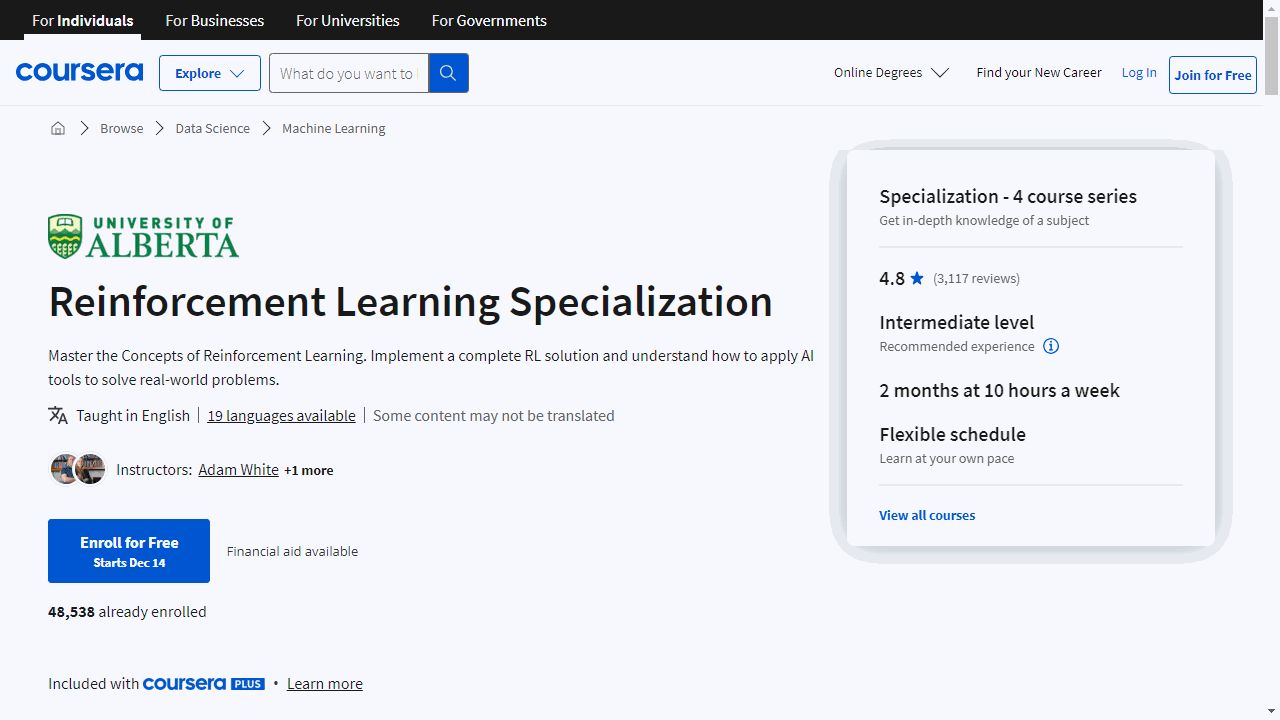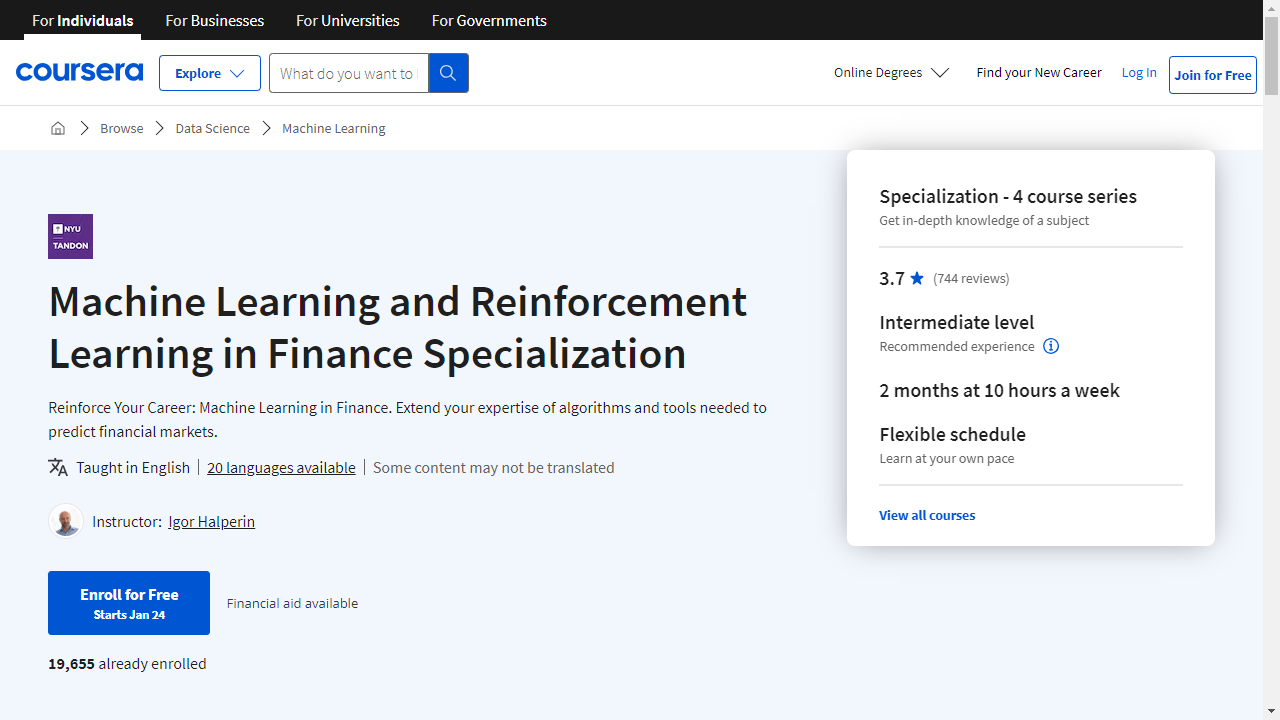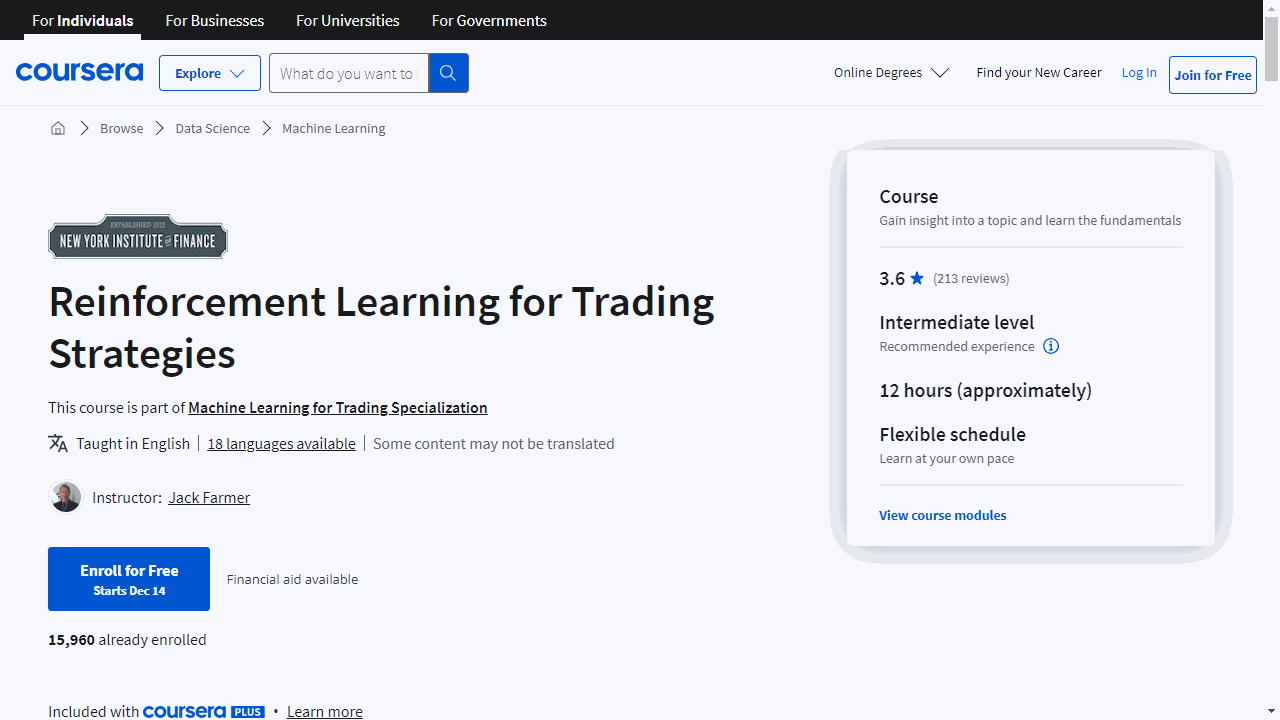Reinforcement learning (RL) is a powerful type of machine learning where an agent learns to interact with an environment and make optimal decisions to achieve a desired goal.
It’s like teaching a dog new tricks with rewards and punishments – the agent learns through trial and error, maximizing rewards and minimizing penalties.
By mastering RL, you can build intelligent systems that can play games, control robots, optimize financial portfolios, and much more, making it a highly sought-after skill in today’s AI-driven world.
Finding a top-notch reinforcement learning course can be a challenge, especially with the abundance of options available online.
You’re probably seeking a course that not only covers the theoretical foundations but also provides hands-on experience with practical applications and popular RL algorithms.
Ideally, you want a course that’s engaging, well-structured, and taught by experts who can guide you through the intricacies of this fascinating field.
We’ve reviewed numerous courses and based on our analysis, Artificial Intelligence: Reinforcement Learning in Python on Udemy stands out as the best course overall.
This comprehensive course provides a solid foundation in RL, covering essential concepts like Markov Decision Processes, Dynamic Programming, Monte Carlo methods, and Temporal Difference Learning.
It also delves into advanced topics like Deep Q-learning and Approximation Methods, equipping you with the skills to tackle complex RL problems.
However, if you’re looking for something more specific, such as a course focused on a particular RL application or a different learning platform, don’t worry!
We have curated a diverse selection of courses to cater to various needs and preferences.
Keep reading to discover our top recommendations for beginners, intermediate learners, and experts, as well as courses that explore specialized areas within reinforcement learning.
Artificial Intelligence: Reinforcement Learning in Python
Provider: Udemy
This Udemy course on Artificial Intelligence: Reinforcement Learning in Python guides you through building intelligent systems using Python.
You’ll begin by understanding the Explore-Exploit Dilemma, a fundamental concept where you must decide between exploiting known options and exploring new ones.
You’ll then dive into algorithms like Epsilon-Greedy, UCB1, and Thompson Sampling, learning how to implement them to solve the Multi-Armed Bandit problem, a classic reinforcement learning challenge.
The course then introduces Markov Decision Processes (MDPs), the backbone of reinforcement learning.
You’ll learn how to model real-world scenarios as MDPs and use the Bellman equation to determine the best course of action for an agent.
You’ll gain hands-on experience by coding a Gridworld simulation, putting your knowledge into practice.
You’ll then explore various methods to solve MDPs, starting with Dynamic Programming.
You’ll implement algorithms like Iterative Policy Evaluation, Policy Iteration, and Value Iteration, gaining practical coding experience.
You’ll then move onto Monte Carlo methods, learning how to use simulations to find the best strategy in a given environment.
Next, you’ll explore Temporal Difference Learning, combining the strengths of Dynamic Programming and Monte Carlo methods.
You’ll implement algorithms like TD(0), SARSA, and Q-Learning, gaining a deeper understanding of how agents learn over time.
The course then introduces Approximation Methods, teaching you how to handle complex problems with large state spaces using Linear Models and feature engineering.
You’ll test your skills on the CartPole environment, a classic reinforcement learning challenge.
Finally, you’ll apply your knowledge to a real-world Stock Trading Project, where you’ll build a system that learns to make profitable trades.
You’ll use libraries like TensorFlow and Theano to create and train your trading agent.
Throughout the course, you’ll be using Python libraries like NumPy, SciPy, Pandas, Matplotlib, and Jupyter Notebook to implement algorithms, analyze data, and visualize your results.
Reinforcement Learning Specialization
Provider: Coursera
This specialization takes you deep into reinforcement learning, teaching you how to build intelligent agents that can make smart decisions.
You begin with the basics, learning how to define problems using Markov Decision Processes, which are like maps for decision-making.
You’ll discover how to use dynamic programming to find the best solutions in these situations, like figuring out the shortest route on a map.
Next, you’ll discover how to train your agents using real-world experience, even if you don’t have all the answers upfront.
You’ll explore algorithms like Temporal-Difference learning and Monte Carlo methods, allowing your agents to learn from their mistakes and successes, just like we do!
You will then explore how to make these agents work in challenging situations.
Function approximation lets you handle complex problems by using powerful techniques like neural networks.
Imagine teaching a computer to recognize images – that’s the power of neural networks!
You’ll also learn about policy gradient methods and Actor-Critic algorithms, which are advanced ways to optimize your agent’s actions.
Finally, you’ll put everything together by building a complete reinforcement learning system.
Imagine creating an agent that can play a complex game like chess or Go.
You’ll learn how to design the game environment, choose the right algorithms, and test how well your agent performs.
This hands-on experience will give you the skills to solve real-world problems using the power of reinforcement learning.
Advanced AI: Deep Reinforcement Learning in Python
Provider: Udemy
This course begins by solidifying your understanding of reinforcement learning basics.
You will delve into states, actions, rewards, and policies, mastering the foundations of intelligent agent behavior.
You will explore Markov Decision Processes (MDPs) and learn how to solve the Bellman Equation, a fundamental mathematical concept in reinforcement learning.
You will then transition from theory to practice using OpenAI Gym.
You’ll get hands-on experience building and testing agents.
You will implement techniques like random search and RBF neural networks, applying them to environments like CartPole and Mountain Car.
You’ll even discover how to use libraries like TensorFlow and Theano, essential tools for building neural networks within a reinforcement learning framework.
The course then advances to cover more sophisticated techniques like TD Lambda, a method for improving the learning efficiency of your agents.
You’ll dive into policy gradient methods, enabling you to directly shape your agent’s actions within an environment.
You’ll then master Deep Q-Learning, a powerful fusion of deep learning and reinforcement learning.
Finally, you will explore A3C, a cutting-edge algorithm for training reinforcement learning agents with remarkable speed and efficiency.
Machine Learning and Reinforcement Learning in Finance Specialization
Provider: Coursera
This specialization equips you with the skills to apply machine learning (ML) and reinforcement learning (RL) to finance.
You will start by exploring machine learning and its financial applications, learning about supervised and unsupervised learning.
The first course culminates in a capstone project where you’ll use supervised ML to predict bank closures.
You will then delve deeper into supervised and unsupervised learning, gaining hands-on experience tackling real-world financial problems.
For example, you’ll learn to design a simple portfolio trading strategy using unsupervised learning.
You will then transition into reinforcement learning, mastering its core concepts and applying them to practical financial problems.
You will learn how to use RL for portfolio optimization, optimal trading, and option pricing and risk management.
You will become proficient in Q-learning, a valuable technique for solving financial problems.
Your newfound skills will be put to the test as you build a simple model for market dynamics using RL.
Finally, you will explore advanced reinforcement learning methods, understanding the link between RL and option pricing, and diving into Inverse Reinforcement Learning for modeling market impact and price dynamics.
You’ll examine the role of perception-action cycles in RL.
Ultimately, you will be able to discuss complex topics like market modeling and learn to apply RL to sophisticated trading strategies in high-frequency trading, credit risk assessment in peer-to-peer lending, and cryptocurrency trading.
Throughout the specialization, you will use Python and libraries like numpy, pandas, and Jupyter notebooks, requiring a foundation in linear algebra, probability theory, and calculus.
Cutting-Edge AI: Deep Reinforcement Learning in Python
Provider: Udemy
This course on Deep Reinforcement Learning in Python begins by solidifying your understanding of fundamental concepts.
You will explore the Explore-Exploit dilemma, understand Markov Decision Processes (MDPs), and gain a strong grasp of Monte Carlo methods and Temporal Difference Learning (TD).
This strong foundation prepares you to dive into the practical applications of reinforcement learning.
You will then explore powerful algorithms like A2C (Advantage Actor-Critic) and DDPG (Deep Deterministic Policy Gradient) using the OpenAI Gym environment.
You will not only learn the theory behind these algorithms but also implement them in Python using libraries such as TensorFlow, NumPy, and Pandas.
You will even work with MuJoCo, a physics simulator, to create realistic environments to train your AI agents.
Imagine training an agent to navigate a complex maze or teaching a robotic arm to manipulate objects.
That’s the power of what you will learn.
The course doesn’t neglect the practical aspects of coding and environment setup.
You will discover how to set up your development environment using Anaconda and become familiar with Jupyter Notebook for interactive coding.
If you are new to Python or need a refresher, the course provides guidance on essential Python tools.
You will become comfortable working with libraries like TensorFlow, Theano, Matplotlib, SciPy, Pandas, and NumPy, essential tools for any aspiring reinforcement learning practitioner.
Unsupervised Learning, Recommenders, Reinforcement Learning
Provider: Coursera
This DeepLearning.AI course on Coursera will guide you through the fascinating world of unsupervised learning, recommender systems, and reinforcement learning.
You’ll begin by mastering clustering techniques like k-means, learning how to group similar data points and use this knowledge for anomaly detection, a technique to identify unusual events or outliers in your data.
Next, you’ll delve into the realm of recommender systems, exploring both collaborative filtering, which analyzes user behavior to make recommendations, and content-based filtering, which focuses on item characteristics.
You’ll learn how to implement these techniques using TensorFlow, a powerful tool for building intelligent systems.
Finally, you’ll conquer the exciting world of reinforcement learning.
Using the Lunar Lander example, you’ll learn how to build AI agents that learn through trial and error.
You’ll gain a solid understanding of key concepts like state-action value functions, the Bellman equation, and advanced algorithms like ϵ-greedy policy and mini-batch updates.
Through these concepts and practical examples, you’ll develop the skills to tackle complex decision-making problems in various applications.
Practical AI with Python and Reinforcement Learning
Provider: Udemy
You’ll begin by setting up your Python environment with Anaconda and Jupyter Notebook, getting your coding playground ready.
Then, you’ll dive into Numpy and Matplotlib, learning how to work with data and create cool visualizations to understand everything better.
You’ll then explore the exciting world of Machine Learning, Deep Learning, and Reinforcement Learning.
You’ll discover how to use Pandas and Scikit-Learn, which are like your data-wrangling sidekicks.
The course then takes you deeper into Artificial Neural Networks using TensorFlow and Keras, teaching you how to build and train powerful AI models.
Get ready to explore Convolutional Neural Networks (CNNs), learning how they work their magic on images.
You’ll work with datasets like MNIST and CIFAR-10, even using your skills on real-world pictures.
You’ll then jump into the world of Reinforcement Learning with OpenAI Gym, a platform for building and training AI agents that can learn and make decisions.
You’ll master techniques like Q-Learning and Deep Q-Learning, even building an agent that can play Atari games just like in the research papers!
To top it off, you’ll learn how to create your own custom OpenAI Gym environments, giving you the power to apply your skills to unique challenges.
Reinforcement Learning for Trading Strategies
Provider: Coursera
This course on Coursera provides a fantastic opportunity to learn how to use reinforcement learning (RL) to build better trading strategies.
You will start with the basics of RL, exploring fundamental concepts like value iteration, policy iteration, and Q learning.
You will discover how these techniques can be used to optimize your trading strategies, making them more efficient and potentially more profitable.
The course then dives into more advanced RL techniques that are particularly useful for analyzing financial markets.
You will explore Deep Q Networks (DQNs), which are a type of neural network designed to handle complex decision-making processes.
You will learn how to use Long Short-Term Memory (LSTM) networks, another type of neural network that excels at processing time series data, a common format for financial data.
The course also covers policy gradients and the actor-critic method, providing you with a comprehensive toolkit for developing sophisticated trading agents.
Through hands-on exercises using the Qwiklabs platform, you will gain practical experience in building your own RL trading system from the ground up.
The course guides you through each step of the process, from data preparation and model training to implementing risk management techniques like portfolio risk reduction.
You will even learn about AutoML, a cutting-edge technology that automates parts of the machine learning process.
The course explores different types of AutoML, including AutoML Vision for image data, AutoML NLP for text data, and AutoML Tables for structured data, showing how they can be applied to various financial tasks.
Also check our posts on:








